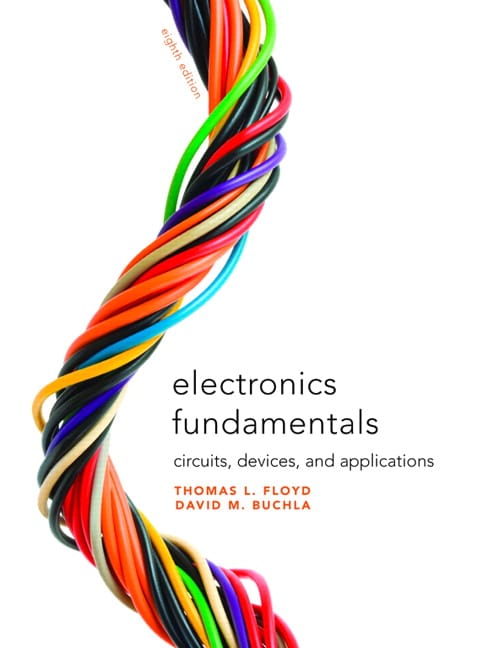Fundamentals of electronic devices and circuits
Data: 3.09.2018 / Rating: 4.8 / Views: 730Gallery of Video:
Gallery of Images:
Fundamentals of electronic devices and circuits
Electronics is the study of electronic components, circuits, devices characteristics to form electronic machines and systems. Electronics Components Passive Components Commencing with an introduction to semiconductors and pnjunction theory, the Fifth Edition of Fundamentals of Electronic Devices and Circuits covers all the most important semiconductor devices in general use today. The operation of each device is carefully explained, and its characteristics and parameters are discussed in detail. This unique book shows just how simple it is to design electronic circuits, using little more than Ohm's law and the capacitor impudence equation. Numerous practical circuit design examples are offered using currently available devices and standardvalue components. Commencing with an introduction to semiconductors and pnjunction theory, the Fifth Edition of Fundamentals of Electronic Devices. Electronics Fundamentals: Circuits, Devices Applications (8th Edition) [Thomas L. FREE shipping on qualifying offers. This renowned book offers a comprehensive yet practical exploration of basic electrical and electronic concepts This book, Electronic Devices and Circuit Application, is the first of four books of a larger work, Fundamentals of Electronics. It is comprised of four chapters describing the basic operation of each of the four fundamental building blocks of modern electronics: operational amplifiers, semiconductor diodes, bipolar junction transistors, and. This renowned book offers a comprehensive yet practical exploration of basic electrical and electronic concepts, handson applications, and troubleshooting. Written in a clear and accessible narrative, the 7th Edition focuses on fundamental principles and their applications to solving real circuit. This book, Electronic Devices and Circuit Application, is the first of four books of a larger work, Fundamentals of Electronics. It is comprised of four chapters describing the basic operation of each of the four fundamental building blocks of modern electronics: operational amplifiers, semiconductor diodes, bipolar junction transistors, and. This book is based on the principle that an understanding of devices and circuits is most easily achieved by learning how to design circuits. The text is intended to provide clear explanations of the operation of all important electronics devices generally available today, and to show how each device is used in appropriate circuits. way that complex digital integrated circuits are built from circuits of less sessions as collaborative studies, or in the laboratory as interactive exercises. The order of the labs follows most electronic textbooks. The first six labs cover the fundamental circuits of gates, encoders, binary addition, Fundamentals of Digital Electronics. ELECTRONIC DEVICES AND CIRCUITS MM 100 Time 3 Hrs Sessional 30 L T P Theory 70 3 1 0 Pass Marks 40 OBJECTIVE: NOTE Two questions are to be set from each unit. Electronic Fundamentals and ApplicationsPrentice Hall. For DCAC Circuits courses requiring a comprehensive, all inclusive text covering basic DCAC Circuit fundamentals with additional chapters on Devices. This renowned text offers a comprehensive yet practical exploration of basic electrical and electronic concepts, hands. Chapter 1 Quantities and Units. 11 Scientific and Engineering Notation. 12 Units and Metric Prefixes Download Free Sample This book, Electronic Devices and Circuit Application, is the first of four books of a larger work, Fundamentals of Electronics. Fundamentals of Electronic Devices and Circuits. This unique book shows just how simple it is to design electronic circuits, using little more than Ohm's law and the capacitor impudence equation. The laboratory investigations in this manual are designed to demonstrate the theoretical principles set out in the book Fundamentals of Electronic Devices and Circuits, 5e. A total of 43 laboratory investigations are offered, involving the construction and testing of the circuits discussed in. Description For DCAC Circuits courses requiring a comprehensive, all inclusive text covering basic DCAC Circuit fundamentals with additional chapters on Devices. This unique book shows just how simple it is to design electronic circuits, using little more than Ohm's law and the capacitor impudence equation. Numerous practical circuit design examples are offered using currently available devices and standardvalue components. Commencing with an introduction. This comprehensive and wellorganized text discusses the fundamentals of electronic communication, such as devices and analog and digital circuits, which are. This set of Electronic Devices and Circuits Multiple Choice Questions Answers (MCQs) focuses on Basic Concepts. A solid copper sphere, 10 cm in diameter is deprived of 1020 electrons by a charging scheme. PSpice for Circuit Theory and Electronic Devices is one of a series of ve PSpice books and introduces the latest Cadence Orcad PSpice version 10. 5 by simulating a range of DC and AC exercises. Buy Electronics Fundamentals: Circuits, Devices and Applications 8th edition ( ) by Thomas L. Buchla for up to 90 off at Textbooks. This text is designed for the first two or three electronic courses in the typical associate degree program in electronic technology. It includes both DC and AC circuits as well as semiconductor fundamentals and basic linear circuits. A unique feature of this book is that it shows just how simple it is to design electronic circuits, using little more than Ohm's law and the capacitor impudence equation. Numerous practical circuit design examples are offered using currentlyavailable devices and standardvalue components. Fundamentals of electronic devices and circuits: lab manual, 2009, 212 pages, David Bell, , , Oxford University Press, Incorporated, 2009 This book, Electronic Devices and Circuit Application, is the first of four books of a larger work, Fundamentals of Electronics. It is comprised of four chapters describing the basic operation of each of the four fundamental building blocks of modern electronics: operational amplifiers, semiconductor diodes, bipolar junction transistors, and field effect transistors. This book provides an excellent introduction to electronic circuit design. The text is divided into two parts. Part I provides an introduction to basic electronic theory and Part II is designed to be a practical manual for designing and building working electronic circuits. For DCAC Circuits courses requiring a comprehensive, all inclusive text covering basic DCAC Circuit fundamentals with additional chapters on Devices. This renowned text offers a comprehensive yet practical exploration of basic electrical and electronic concepts, hands. Electronics Fundamentals: Circuits, Devices Applications Edition 8 This renowned book offers a comprehensive yet practical exploration of basic electrical and electronic concepts, handson applications, and troubleshooting. Summation Notation also known as Sigma Notation. A simple way of expressing the sum of the values of a sequence. This is seen in PreCalculus, Calculus 1 (AP Calc AB), and Calculus 2 (AP Calc BC). Electronic Circuits i About the Tutorial This tutorial explains the very basic circuits in Electronics and Communications. The circuits mentioned in this tutorial are mostly related to the applications of diodes. The components mentioned in Basic Electronics tutorial have their applications seen here. 4 Introduction to Electronic Devices, Fall 2006, Dr. Dietmar Knipp Fundamentals of Semicondutors 2. 1 Semiconductors General Information The purpose of this part. Electronic Devices and Circuit Theory R. Boylestad Electronics Fundamentals 8th edition FloydBuchla 2010 Pearson Education, Upper Saddle River, NJ. Lesson 2: Transistors and Applications. Electronics Fundamentals: Circuits, Devices Applications (8th Edition) pdf by David L Buchla Electronics so the next stage we can simply click on to these devices work. Contemporary Electronics: Fundamentals, Devices, Circuits and Systems offers a modern approach to fundamental courses for the electronics and electrical fields. It is designed for the first two or three electronic courses in the typical associate degree program in electronic technology. Commencing with an introduction to semiconductors and pnjunction theory, the Fifth Edition of Fundamentals of Electronic Devices and Circuits covers all the most important semiconductor devices in general use today. For example, electrical current can range from hundreds of amperes in power applications to a few thousandths or millionths of an ampere in many electronic circuits. This range of values is typical of many other electrical quantities also. Silicon is the most common material used to build semiconductor devices. Si is the main ingredient of sand and it is estimated that a cubic mile of seawater contains 15, 000 tons of Si. Written in a clear and accessible narrative, the Seventh Edition focuses on fundamental principles and their applications to solving real circuit analysis problems, and devotessix chapters to examining electronic devices. Electronics Fundamentals: A Systems Approach takes a broader view of fundamental circuits than most standard texts, providing relevance to basic theory by stressing applications of dcac circuits and basic solid state circuits in actual systems. Electronic Devices (Electron Flow Version), 10e, provides a solid foundation in basic analog electronics and a thorough introduction to analog integrated circuits and programmable devices. The text identifies the circuits and components within a system, helping students see how the circuit relates to the overall system function. The study of semiconductor devices and related technology is considered a branch of solidstate physics, whereas the design and construction of electronic circuits to solve practical problems come under electronics engineering. Floyd's comprehensive treatment of elecric circuits fundamentals is here teamed with six chapters devoted specifically to the type of electronic devices, and applications, students are. Fundamentals of Electronic Devices and Circuits. The laboratory investigations in this manual are designed to demonstrate the theoretical principles set out in the book Fundamentals of Electronic Devices and Circuits, 5e. A total of 43 laboratory investigations are offered, involving the construction and testing of the circuits discussed in the textbook. Fundamentals of Electronic Devices and Circuits, Fifth edition Higher Fundamentals of Electronic Devices and Circuits, Fifth edition in the Higher Circuit applications are then treated, and the. electronic circuits will allow the mechanical engineer to evaluate whether or not a given electrical specification is reasonable and feasible. The following text is
Related Images:
- Mp3 songs songs hindi
- Friday night lights s01e04
- Heavy duty 2
- The Long Hot Summer
- How i met s09e16
- Toni braxton love marriage divorce
- Naruto shippuden 376 720p
- The daily show coltrane
- Castle 5 5
- Daryl hall hall
- The Full Monty Level 4
- Biggie big pop
- Toppers in concert
- Inspection Checklist Template Excel Vehicle
- A walk to remember soundtrack
- Oru Desathinte Katha By S K Pottekkatt
- El Principe Destronado Delibes Pdf
- Movies dual english hindi 2018
- Report 2018 04 17
- Knock knock knockin on heaven s door
- The Complete Keyboard Player Book 3
- Vision Future Framework Standards Impairment
- Ben 10 2018
- Jacob Ladder multi
- September music 2018
- I write sins not tragedies
- Jason derulo tatto
- Hino W04d Workshop And Parts Manuals
- S01e03 faking it
- U aint bout that
- The Lawrence welk show
- Cryptography and network security computer science
- Dvd walk with me in hell
- Gossip girl season 6
- Suits s01 eng sub
- Robot and monster s01e20
- The come up dvd 17
- Mastering the American Accent
- American Blue Film Www Com
- Irina voronina killer shots
- Meek mill ty dolla
- Stop motion pro
- Aqua teen hunger force movie
- Thomas and the magic railroad 2000
- Dissidia 012 mods ppsspp
- Ryders Ridge
- Dracula Untold 2018 1080p
- Trey Anastasio Band
- Zero hour us s01e02
- Sendalu
- Rock dj mixtape
- Test Drive Unlimited 2 Patch Fr Pc
- Winsin y yandel
- Bonnie sexually broken
- The 22 day vegan diet
- 80 90 Rnb
- The fall castellano
- Merk kremont
- WWE Divas s03e05
- Artie lange roast
- Super 8
- Seasoned Players 4
- Cambridge grammar for first
- English train your dragon
- It like that
- Samsung Hard Disk Reset Password
- Queensryche real world
- Ost scott pilgrim
- The court jester nl
- Adventures of Ichabod Mr Toad
- Sniper path of vengeance torrent
- Calculus By Swokowski 6Th Edition Solution Manual Pdf
- 3d epic latino
- The Square
- Sketching User Experiences Greenberg Pdf
- The whitest boy alive rules
- Adobe photoshop cs2 keygen by paradox
- Somo tao jovens
- Elephorm after effects
- Cancer de estomago causas y consecuencias
- Love And Rockets Vol 9 Flies On The Ceiling
- The Works Anatomy Of A City
- Factor Analysis in Chemistry
- Breaking bad season 5 480
- Dts hd ma 1080p
- Orange is the new black sujaidr
- John Deere Tractor Fabric Panel
- Nl a perdre la raison












